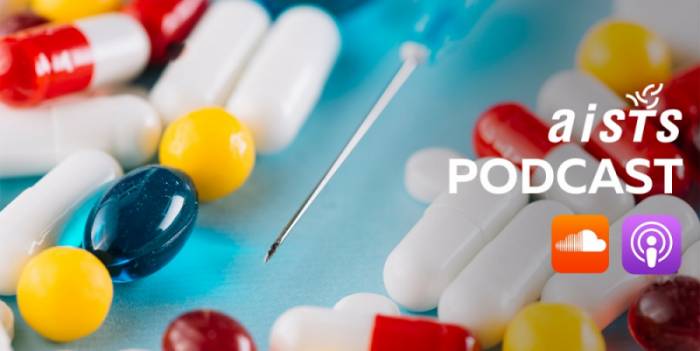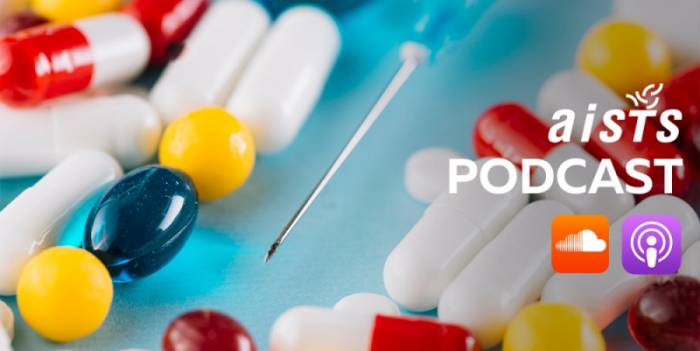
AISTS SPORT MEDICINE PODCAST #49
WHAT IS THE ATHLETE’S BIOLOGICAL PASSPORT?
This month’s AISTS Sport Medicine Podcast
This month’s AISTS Sport Medicine Podcast discusses the Athletes’ Biological Passport (ABP). What is it exactly? How does it help anti-doping? How can it be improved and how does the future look like?
Doping scandals are seen more and more in the media and the position of anti-doping strategies and organisations is changing in the public eye. Belief in the system is fading and this can be a threat to the Olympic Movement. The Athletes Biological Passport is a reliable tool that can, working with other complimentary methods such as education, intelligence and targeted testing, make the anti-doping system efficient and reliable.
Thomas Roos and Andrei Krasilnikau, Class of 2018, discuss the ABP, its benefits, and the possible evolutions and improvements that science is already developing. Spoiler alert: it is all about protecting clean athletes as well as catching the cheaters! Listen to learn more.
Thomas: Integrity is essential to a functioning sports ecosystem, and the recent doping scandals have threatened the Olympic Movement. The public, media, and athletes themselves have lost faith in the anti-doping system.
Andrei: The Athlete Biological Passport (ABP) is one tool used by WADA in the fight against doping. Today we will discuss how the ABP can be improved in order to help restore confidence and credibility in the anti-doping movement.
Thomas: I am Thomas Roos, professional triathlete and scientist from the United States. Andrei: And I am Andrei Krasilnikau, professional cyclist and engineer from Belarus.
Thomas: You might have heard of the ABP, but not understand what exactly it is.
Andrei: The ABP is a tool to monitor biomarkers of doping over time to indirectly reveal the effects of doping. It is used in complement to other analytical methods of direct detection. It includes 3 modules testing for levels of blood parameters, hormones, and steroids.
Thomas: Andrei, as a professional athlete, can you explain how the ABP works?
Andrei: Throughout my career I provide blood samples and the results are entered into an anti- doping database and management system called ADAMS. The system tracks my values over time and calculates a normal range personalized for my body.
Thomas: Yes, the value provided by the ABP is that it can help determine what is physiologically
normal and what is abnormal.
Andrei: And the ABP is used to flag suspicious athletes for more frequent targeted analytical testing. This is why as a Belarussian cyclist I get tested more often than you Thomas.
Thomas: Haha true.
Andrei: Thomas, is it true what we always hear from WADA and anti-doping scientists that the ABP is an effective and efficient tool to fight doping?
Thomas: The short answer is yes it works to counteract doping. The long answer is more nuanced. However, all parties agree that despite shortcomings in the ABP it is one of the tools, that together with education, intelligence, and targeted testing, make the overall system highly efficient.
Andrei: From an athletes perspective, the ABP serves as a deterrent. The risk of getting caught for doping is much higher today than in the past since the ABP has a broad scope to detect downstream effects of many possible doping methods. This changes the athletes mindset in terms of risk to reward ratio.
Thomas: From a scientists perspective, the ABP serves as an accurate and valid method to longitudinally monitor an athletes individual biology. The decision limits for an abnormal finding are determined using a Bayesian statistical model with an error rate of one in one thousand.
Andrei: But it is known publicly through media coverage, interviews with athletes who have been caught, and recent scientific investigations that it is possible to beat the ABP, right?
Thomas: Yes, we know that athletes can beat the ABP through various methods, such as microdosing, however we also know that the resources needed for an effective doping scheme are not sustainable in the long run.
Andrei: Sociology research tells us that no matter the circumstances or harsh sanctions some athletes will still cheat, so anti-doping can never be 100% effective. It is important to recognize that the ultimate goal of the anti-doping system is to minimize the prevalence of doping, not eliminate it.
Thomas: That leads us nicely to our next topic of how the ABP can be improved to achieve that goal. Andrei, what are the next steps for the evolution of the ABP?
Andrei: Briefly, the ABP can first, incorporate new biomarkers and second, be used as a certification for clean athletes.
Thomas: In the last 2 years WADA research has focused on studying whether “omics” technologies, specifically proteomics and metabolomics, can improve the ABP.
Andrei: Thomas, as a scientist, how would that work?
Thomas: Well these methods would be able to account for more of the confounding factors and account for greater individual variation in ABP values. Through incorporating these new biomarkers we can add predictive power to the statistical modelling.
Andrei: Come on Thomas … let’s be honest, most elite athletes don’t bother themselves with the detailed science of the ABP. Athletes care about their authenticity and image in the public, media, and peer groups.
Thomas: I completely agree, Andrei. So, in our opinion, how can we address this?
Andrei: We propose that the anti-doping community as whole switches the focus away from not only catching cheaters into also emphasizing the protection of clean athletes.
Thomas: So what new directions can be used to pursue this idea of a badge for clean athletes?
Andrei: Academics and athletes have discussed using a performance passport to monitor power output ability over time. Together with the ABP this provides a more precise line between what is normal and what is not.
Thomas: So the idea is to certify to the best of our current knowledge whether an athlete is clean or not. In turn, providing athletes the opportunity to distinguish themselves as “organic,
home-grown, all-natural” humans.
Andrei: We can further create certification levels of cleanliness. For example, bronze, silver, and gold status each with an increased level of confidence. Status could be awarded based on the amount and quality of biological and performance data an individual athlete is willing to contribute.
Thomas: I see benefits for providing clean athletes a platform to enhance their authentic brand, as well as empowering athletes to play a larger role in the anti-doping system.
Andrei: And let’s not forget this would improve transparency in the anti-doping process, shift the media focus into a positive message, and hopefully contribute towards restoring credibility in sport.
Thomas: To finish up we will hear from Dr Martial Saugy, the director of the Center for Research and Expertise in Anti-Doping sciences at the University of Lausanne. Importantly, he was previously the head of the WADA accredited Lausanne anti-doping lab and was a part of the scientific team that created the ABP.
Andrei: We asked Dr Saugy how he thinks the ABP can be improved and what he predicts for the future of the anti-doping movement.
Dr Saugy [quote]: I think today the challenge is rather to show for those who are clean to show “I am clean”. This will be more and more diffcult for those who are cheating.
Thomas: We are optimistic that future improvements in the Athlete Biological Passport will better serve the needs and interests of clean athletes.
You can find more AISTS Sport Medicine podcast on our Soundcloud channel or on the Apple Podcast app. To learn more about the AISTS Master of Advanced Studies in Sport Administration and Technology, visit www.aists.org/education
Photo Freepik





